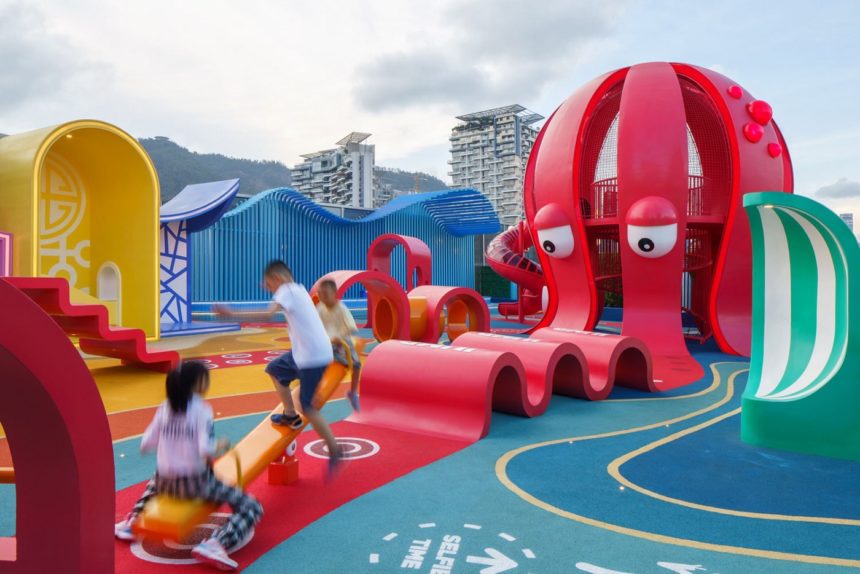
A lot of experiential artists and directors present their work as “telling stories in physical space,” but I’ve spent the last 15 years or so presenting creative concepts for interactive experiences of all kinds and I just have never thought of myself as a storyteller. At the studio, I am often searching for other ways to describe our process of designing experiences, and I’ve begun to say that what we’re doing is building playgrounds.
I like the idea of playgrounds because one of my consistent goals is to make experiences that are as viscerally engaging for an adult as a giant curly slide is for a kid. Working in an interactive medium I am drawn to ideas where users are not simply sitting and listening, but that they are in control of their destiny, they have arrived somewhere special and are exploring what has been created. When you are at the playground, you learn from what you do, what you touch, how it feels. There is also no prescribed beginning, middle, and end but rather a journey that has its own arc no matter where you start. The story of your experience is yours to tell.
I am not alone of course, there are plenty of experience projects called ‘playground’ ( I’ve worked on a few of these ), there are other articles about the need for adult playgrounds and the term may join the hallowed list of industry buzzwords, if it hasn’t already. So I spent some quality time with OG source material to figure out why playground as an idea resonates with people who create interactive experiences for physical places. ( I have kids so I get a lot of research time on this topic. )

Learn by doing.
Play is learning. Kids at playgrounds are learning how to move, how many wood chips they can shove in their pockets, and how they can jump off a structure without breaking their legs. Everything we learn begins with play, dabbling in new, trying things out.
Use a pile of jackets as a slide-toboggan.
Anyone that wants a lesson in human behavior should spend an afternoon watching kids do just, unexpected things on slides. Sometimes I look at hand holds underneath a slide and think- how did they decide that anyone would do this? Not only accounting for unpredictable users but rewarding their efforts takes all the skills we have available.
Make mud pies with a friend.
I always shoot for the amount of social interaction at a playground. Playgrounds offer both cooperative and competitive tools, side by side slides, see-saws, and carousels that need 3 people. People of all ages are more likely to interact with each other when there are tasks to do that are involving enough to distract them from the stress of social interaction.
Pretend to be a firefighter.
The best playgrounds offer a chance for kids to absorb themselves in different identities, to imagine themselves as being able to fly or to adopt alternate personas like a firefighter or unicorns, or unicorn firefighters. It’s thrilling to be able to live for a moment as someone else, to see the world through their eyes and to have others see you as another version of yourself.
Carve a slide into the side of a hill.
There are elements in a playground that are freestanding, that change the environment they are in, but there are also elements that use the existing landscape like a hill, a stream or a field incorporating what is there into the theme of the park. For an experience I always think about the balance between what to use from a physical location and what to bring to it.
Journey to the giant slide.
You can’t just have one centerpiece, like a slide with a few things around it- you would have a pretty flat experience. Instead modern playgrounds provide many different paths that lead to the big payoff, with smaller interactions along the way. This means a seamless experience of being engaged the whole time instead of lining up and waiting. There’s no start and end to your experience, yet everything is connected. You can take paths through it around it, vary those paths. But step 1 in an experience can be someone else’s step 5 and it makes sense for both people. Playgrounds have excellent flow.
What can people hear?
Playgrounds are like sensory boards, there are different textures, sounds and materials throughout the space. Each sense has a location. There are bells, smooth, and bumpy textures to feel, kids even lick things. Even disgusting things can be reimagined into compelling experiences. While many designers are conscious of addressing many senses, it is also important to vary those senses throughout a space to create a kind of sensory map where different locations highlight just one of the senses.
Hang upside down like an idiot.
Changes in body position often result in changes in how you think. Experiencing something while lying down, or running will change how you feel about it. I love how many different body positions you can find yourself in at a playground and what each one of those means.
Jump off the edge.
When we talk about using danger in experiences we are asking someone to risk something. That risk could be safety, embarrassment, losing a game, stage freight etc. The importance of danger within a controlled environment is that we allow for large payoffs when someone overcomes their fear. If playgrounds were completely fearless they wouldn’t have children on them, in fact what makes them fun is the possibility of conquering what they thought they couldn’t do yet. So many branded experiences for adults do not include any type of risk, and it’s almost always the culprit if an experience is boring. The trick for a designer is knowing what we are asking someone to risk and how we are helping them overcome it.
Hide under the stairs for a bit.
There is a range of energy levels in a given playground. The slides are intense, the running track is high energy- but there are also quiet, small spaces, even cubbies that offer a break from the chaos. It’s important for designers to plan for areas people go when they are overwhelmed, and transition areas that prepare you for what’s next.
Wide ranges of users.
Picture the height and ability differences between a 2 year old and a 12 year old. Designers have to account for big ranges of challenges at a variety of heights for varying physical and technical abilities. It’s not an afterthought, it’s planning from the beginning.
That big step that little kids can’t climb.
Usually the path to the highest slide contains the highest steps so that if you’re not big enough for the big slide, you have trouble with that first step. So naturally smaller kids filter to the areas that are easier to climb, fewer little kids at the top of the big kids slides. Each interaction signals at the start what you’re getting into.
Parents standing around with their coffee cups are part of the action.
For every experience there are the doers and the non doers. But these spectators still want to be part of everything and to engage vicariously rather than not at all. Plan spaces for active observers, because spectators are the photographers, historians, and sometimes teachers of an experience.
Making a playground is a lot of work.
I marvel at the enormous amount of expertise, material and physics research and testing, engineering architecture and planning. A playground designer makes a tunnel and knows that people wont simply only go through it but slide on top, and swing underneath it and try to fill it with dirt and matchbox cars. All the choices of supports, materials and designs must be ready to withstand the actual use of a playground.
This playground looks different than ours.
You can tell a lot about a community by what their playgrounds look like. Some are wild and natural connections to the environment, others are artful celebrations of creativity, some functional and minimal, some encourage risk taking- each experience is a kind of expression of the values people who live nearby care about.
Creating play is an incredible responsibility.
At our studio, Red Paper Heart, we take all these aspects of a playground into consideration for each new project. During a creative sprint with a new client we look for ideas, themes, or goals that can be used to create our client’s unique playground. We ask ourselves what the range of activities will be, how they flow, what we want people to learn, to feel, how participants can interact with others, how everyone can express themselves within the world we create.
But where it gets really interesting is taking all the immersive qualities of the playground and applying it to getting across an idea. For our studio this has been ideas like: reminding people how many National Parks are all around them, or helping a client announce urban development plans to a community in the right way. Sometimes we were given a theme to respond to such as “Experience the power of the human voice.” We then explored how these themes translated into interactions that helped people learn.
People can learn about data literacy, blockchain, the history of a city, and more through the act of playfully testing their abilities in a certain subject. Play propels them forward and the experience of that action that helps them to learn.
If a client wants to feature their story, we don’t tell it as a story, we let people be inside it, throw it on the wall and recontextualize it, or walk around wearing it like a bear suit. Our goal is to write the rules of how a brand translates into interaction, emotional engagement and responsive experiences.
You may still prefer the ring of the word “storytelling,” but when it comes to stories, the ones I am most interested in are the ones users tell of their own experiences.
